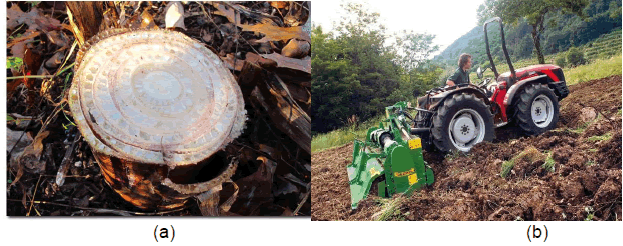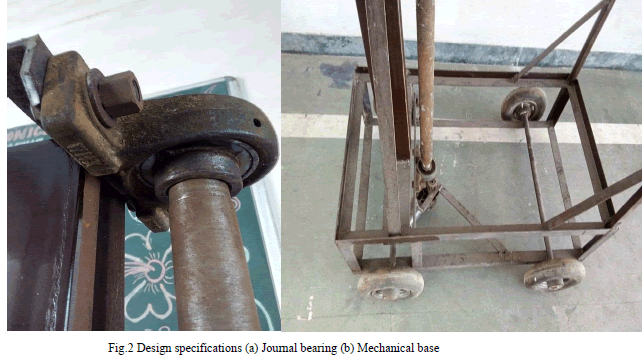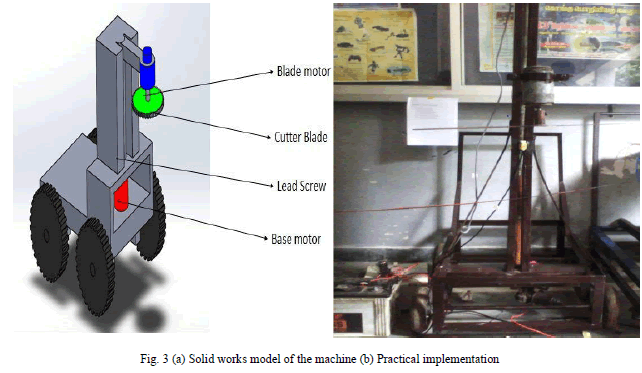ISSN ONLINE(2319-8753)PRINT(2347-6710)
ISSN ONLINE(2319-8753)PRINT(2347-6710)
Balaji A1, Jahir Hussain H2, Faheem Ashkar MR2, Gowsick C S2, Subakar K2
|
| Related article at Pubmed, Scholar Google |
Visit for more related articles at International Journal of Innovative Research in Science, Engineering and Technology
This paper deals with the design and fabrication of low cost cutting machine for banana tree on a large scale. In existing system, the cutting and decomposition process takes much time and the cost requirement is also high.The mechanical part of the machine consists of lead screw, journal bearing and cutter blade. High strength lead screw is used to eliminate the thrust. The cutter blade is designed to rotate at high speed. The electrical system of the machine contains wiper motor and inductive type proximity sensor. The lead screw coupled with wiper motor rotates in clockwise direction. When proximity sensor detects the top position, signal is sent to the relay and reverses the motor direction. During downward movement cutter blade turned off using multipoint relay. Due to the continuous motion of the cutter blade and lead screw movement, the banana trees are cut into pieces. The machine is designed with economic feasibility by including sensors and relays.
Keywords |
| Agriculture, Banana/Plantain tree, Proximity sensor, Journal bearing, Economic feasibility. |
INTRODUCTION |
| Agriculture is the backbone of our country. There are various types of plants cultivated by our ancestors. Modern farmers follow the same types of cultivation method with improved techniques. Among these, banana tree cultivation plays the important role. Nearly forty percentages of farmers in southern India cultivates banana tree. Banana is a tropical herbaceous plant consisting of an underground corm and trunk comprised of concentric layers of leaf sheaths [4]. At 10 to 15 months after the emergence of a new plant, its true stem rapidly grows up through the centre and emerges as a terminal inflorescence which bears fruit. In India cutting of banana tree is done by tractor and decomposition method. This method is followed by farmers in wide range. The cutting of banana tree takes some time for stem to completely decompose. |
| Due to increase in the price of raw materials such as fertilizer, pesticide, farming equipment, farmers wish to gain the cost effective methods for cultivating their banana tree. By utilizing this method they will boost the economic growth and thus in turns add up to nation building. The cutting process is made simple and efficient one by inducing automation. The traditional method of cutting banana tree is expensive and required skilled labour. A feasible machine is required to make the process easy. By utilizing the engineering principles and automation techniques, this machine will makes the thing easier and user friendly. |
| As discussed earlier, the conventional method of banana tree cutting is done by direct decomposition and rotary tractor method. This process is tedious one, the proposed machine aims at making the things simple and easy. The main motto is to introduce automation and make this process cost effective. The process involves cutting of banana tree into pieces. The entire setup is mounted on the mechanical base with moving tire arrangement. Many farmers feel difficult to spend time and money. Thus, by making the machine that operates user friendly invokes many farmers to feel happy. The major human operation in the process is just to switch on the electrical power and by driving the machine by hand. |
| These operations are so simple and easy that anybody can do the job convincingly. Therefore the resulting cutting process will be cost effective user friendly and feasible. |
EXISTING SYSTEM AND PROPOSED SOLUTION |
| In the existing direct decomposition method, farmers used to fill their cultivated land by water and kept it wet for five days [1]. After few days banana trees are made into big pieces which were buried into the wet clay using tractor as shown Fig 1 (a). This makes the banana tree to completely decompose within one month. The raw materials used in this process are wet clay. This method involves two types of work. One is cutting of trees and other is using tractor to complete process. This method is still followed by the farmers.In rotary tractor method the banana trees are crushed into pieces using tractor. The farming land is made dry and then tractor driven by skilled labour is made to cut the trees as shown in Fig 1 (b). Then the pieces are filled with water and let them undisturbed for some period to decompose completely. This method takes much time to cut the trees. |
 |
| Fig 1. Existing methods (a) Direct decomposition method (b) Rotary Tractor method |
| The major limitations of existing systems are as follows, |
| 1. They cause uneven cutting of banana trees which resulted in improper decomposition. |
| 2. They take minimum ten days to completely decompose trees. |
| 3. The man power and cost for rotary tractor is high. |
| 4. May cause wastage of cultivating time. |
| The proposed system is designed entirely focuses on making cost effective machine at the same time in feasible format. The machine is designed to be handled by any person easily which cannot be processed in existing methods. This paper is mainly concentrated on the requirement of small sale farmer to offer them Automatic banana tree cutting machine of moderate cost. The main concept behind this automation process is to simplify the cutting of banana tree process. The cutting blade is connected with the nut of the lead screw. The rotation of the lead screw is controlled with the help of relay and proximity sensor. This sensor detects the position of nut and automatically controls the clockwise and anticlockwise direction of motor. The blade attached with nut is continuously rotated with motor, which makes the cutting process. |
| The advantages of the Automatic Banana Tree cutting machine are |
| 1. Low of machine and easy of maintain |
| 2. Well suited for small scale farmers and not skilled labouris required for working this machine |
| 3. The machine consumes less time for cutting trees |
| 4. Feasible machine and occupies less floor space |
| welding and casting. Then, the automation is done by relay so as to be cheap. The use of microcontroller will reduce the cost of the automation. Then, the proximity sensors and other relays are around a cost price of few hundreds. The motors are easy and economical to buy. Thus overall system is cost effective if the benefits out of it are considered. The operational feasibility includes the following part. Nut moves in the lead screw. It is detected by the proximity sensor. As it is detected, the microcontroller sends signal to the conveyor motor to rotate in opposite direction. Thus, the nut moves up and down. The motor attached with blade rotates continuously [2]. When the nut reaches extreme up or down end again, the proximity sensor detects the nut and reverse the motor rotation. The motor attached with blade rotates at high speed, resulting in cutting of banana trees into pieces at uniform time interval. An external power supply control button is provided to make power on/off. |
| Technically, the above mentioned process is so simple and thus feasible to produce. The microcontroller is programmed with the help of RIDE software. The Embedded C language is used to program the controller process. Then it is dumped into the microcontroller with the help of Willer software. The dumper kit is used to dump the program into the microcontroller. Thus, the microcontroller is ready to be used. Then, the controller is placed in the development board. The connection to the rest of the part is taken from this board. The transformer supplies the power to the components. The motor is driven by 12 V transformers. A separate transformer with high amps rating is used to drive the motor. The microcontroller controls the proximity sensor and motor actuation. Thus it is simple and easy to build the Automatic banana tree cutting machine with the help of microcontroller. |
DESIGN SPECIFICATION AND CALCULATIONS |
| Journal bearing is an important element in this design.Because the balls are rolling they have a much lower coefficient of friction than if two flat surfaces were rotating on each other. Here ball bearing is fixed with stand and connected with shaft and provide less friction as shown in Fig 2 (a). |
| Specification of journal bearing: |
| Mass of bearing = 0.8kg |
| Inner diameter of bearing = 26 mm |
| Total mass of bearing = 1.6kg |
| Type =Point Contact |
| No of bearings used = 2 |
| A lead screw can be used in conjunction with a split nut.Lead screws are typically used well-greased, but, with an appropriate nut, they may be run dry with somewhat higher friction [6]. There is often a choice of nuts, and manufacturers will specify screw and nut combination as a set. |
| Material used = Mild steel |
| Density =7.85×10-6 Kg/mm3 |
| Lead Screw =18 Kg |
| Nut weight = 2.8 Kg |
| Thread Type= V-Thread |
| Threads per Inch = 4 TPI |
| Outer Diameter= 28 mm |
| Inductive proximity sensors switch in the presence of metal. These sensors take 5 to 30 VDC and have a normallyclosed NPN-type output. The sensor has a 12 mm diameter threaded body and the rear of the sensor lights up when the sensor is triggered, allowing easy mounting and adjustment. |
| Supply Voltage = 5 to 30V |
| Dimensions =12 mm, 40 mm |
| Secure sensing distance = 3.2 mm long |
| Maximum output current = 150 mA |
| Operating Frequency = 600 Hz |
| Operating Temperature = -20 to 70 °C |
| The techniques used to fabrication are arc welding and controller process. Arc welding is a type of welding that uses a welding power supply to create an electric arc between an electrode and the base material to melt the metals at the welding point. They can use either direct (DC) or alternating (AC) current, and consumable or non-consumable electrodes. The welding region is usually protected by some type of shielding gas, vapor or slag. To supply the electrical energy necessary for arc welding processes, a number of different power supplies can be used. The most common classification is constant current power supplies and constant voltage power supplies. In our project of Automatic banana tree cutting machine, the power supply used is 2 AC 230 V where one is used to power the control unit and other is used to power the output units (8 amps).In arc welding, the voltage is directly related to the length of the arc, and the current is related to the amount of heat input [3]. Constant current power supplies are most often used for manual welding processes such as gas tungsten arc welding and shielded metal arc welding, because they maintain a relatively constant current even as the voltage varies. This is important because in manual welding, it can be difficult to hold the electrode perfectly steady, and as a result, the arc length and thus voltage tend to fluctuate.The Constant voltage power supplies hold the voltage constant and vary the current, and as a result, are most often used for automated welding processes such as gas metal arc welding, flux cored arc welding, and submerged arc welding. In these processes, arc length is kept constant, since any fluctuation in the distance between the wire and the base material is quickly rectified by a large change in current. For example, if the wire and the base material get too close, the current will rapidly increase, which in turn causes the heat to increase and the tip of the wire to melt, returning it to its original separation distance. |
| Base, as the name implies it is the base setup upon which all whole mechanical setup is kept. The base has a gap of rectangular shaped which is used to keep the battery, Lead screw and the electrical components. Size of the base setup is 120 cm x 80 cm x 50 cm which is shown inFig 2 (b). |
 |
PRACTICAL IMPLEMENTATION |
| The conceptual design including the entire setup is mounted on the mechanical base supported by wheel arrangement is shown in Fig 3 (a). The lead screw rotates in clockwise direction initially by the motion of DC motor. The nut coupled with the thread of lead screw also rotates in up and down motion accordingly. The two inductive type proximity sensors are placed at the extreme end of the lead screw. When it detects the nuts signal is send to the microcontroller and relay. The base motor changes its direction. The motor attached with the blade rotates continuously with high required speed for cutting banana tree. The sensor position is adjusted according to the height of tree. The machine is designed with initial cutting from top position as shown in Fig 3 (b). It continuously travels downward direction. Once it reaches the bottom end, proximity sensor detects the signal and nut moves upward direction. In this manner banana tree is cut from top to bottom. |
 |
CONCLUSION |
| Thus the work design and fabrication of Agro-based automatic plantain tree cutting machine has been made in accordance to the need. The initial mechanical setup of the project is made with mild steel material. The setup is made as such in the Solid Works model. The blade with three wings is used for the cutting operation. The final cutting operation is obtained at the blade end.The wiper motors are used to produce the actuation of lead screw and cutter blade. They are placed accordingly to produce slip free actuation. The Microcontroller has been programmed as stated above to control all the functions. Thus the automation process is taken care of.The sensing of nut has been made with the help of Inductive proximity sensor. They detect the tray when nut reaches the extreme end of the lead screw motion according to the tree height adjustment. The tray is robust and bares the entire mechanical load in the pressing operation.The working condition and the operational costs were estimated accordingly.The remaining process such as controlling the speed of blade has remains for future work. In future the system can be fully automated by providing the remote controlled techniques. |
References |
|